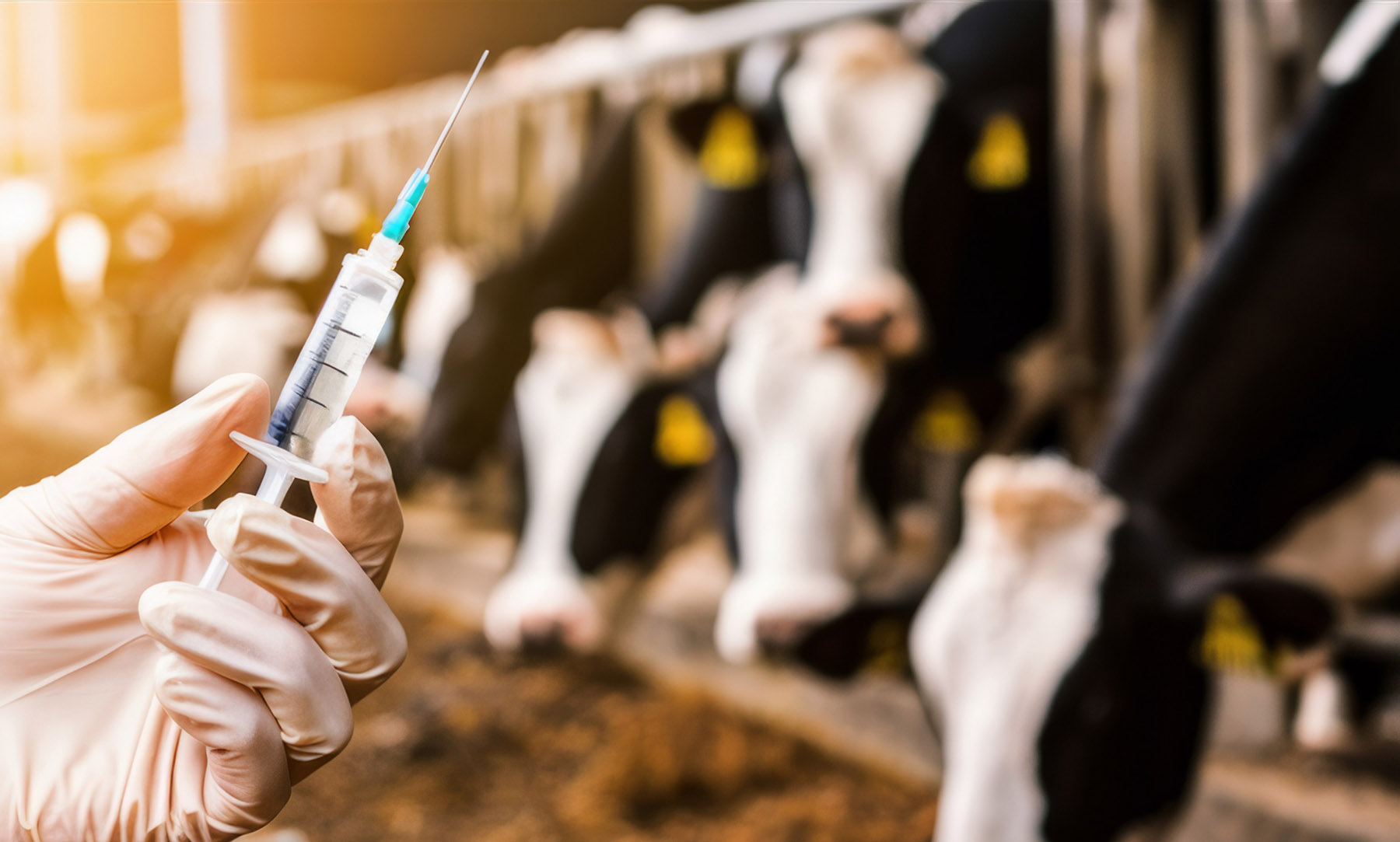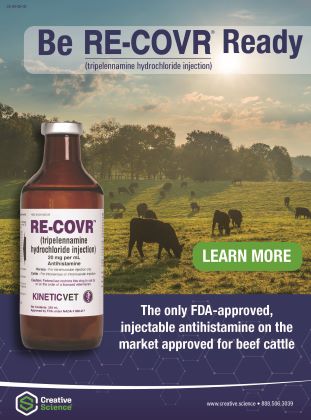Vaccination Reactions

Vaccination Reactions
By Heather Smith Thomas
Occasionally cattle react to vaccine. An allergic reaction can be mild and local (swelling at the injection site after vaccination) or serious and fatal—if the animal goes into anaphylactic shock.
The vaccines administered to cattle contain antigens that are “foreign” to the animal’s body. With vaccines, the goal is for the body to recognize these as foreign and develop antibodies to combat these antigens in the future. Vaccination enables the animal to create an immune response. On rare occasions, however, the animal may develop an acute allergic reaction to a foreign substance. Reactions can range in severity from hives/itching to systemic shock–with fluid in the lungs and sudden death.
Dr. Tim Nickel, Boehringer Ingelheim, says the reason we give vaccines is to stimulate the immune system, but sometimes this results in hyper-stimulation. “When we see severe reactions, like anaphylaxis, it’s a hypersensitivity reaction in that individual animal,” he says.
The most common vaccine reactions are due to the antigen itself, but can also be due to the carrier or adjuvant. “The adjuvant gives a little extra push, to achieve better immunity and protection. We probably saw more reactions to some of the older adjuvants than we see today with modern adjuvants, but we still see some reactions associated with these—and they are most commonly used in killed vaccines. Of the killed vaccines, most reactions are with the clostridial products (7-way and 8-way vaccines),” says Nickel.
Often these reactions are just local swelling, rather than anaphylactic reactions. “The animal is sensitive to the adjuvant; these vaccines may have oil adjuvants that provide extra stimulation of the immune system. We often see a lump at the vaccination site, especially since label instructions today are to put it in the neck and administer it subcutaneously,” he says.
Local Swelling
In the past, most vaccines were injected into muscle. “Even though there may have been a lump, it was not as visible, and there was also more tissue to absorb it. It was probably not as large, and would also resorb more quickly, as well. You might not have even seen much of a lump, in that location, but usually this results in some scar tissue and affects meat quality. A subcutaneous lump is more visible and may last longer.,” he explains.
“I handle phone calls from producers and veterinarians regarding reactions for our vaccines, and the lumps/swellings are most common. In that situation we generally see a number of animals in the group affected—not just one or two. It might be as much as one-third to half the herd. In these situations it’s usually not a big concern because these reactions are temporary. These lumps go down and disappear after a few days, without treatment,” Nickel says.
“You need to determine whether those lumps might be abscesses rather than reactions to the vaccine. If it’s an abscess it will eventually break and drain puss. This is not caused by the vaccine but by a dirty needle. This can happen if a person keeps using the same needle on too many animals, or injects through a dirty hide or wet skin; if the hair is wet there is more risk of taking some contamination in with the needle. If you are seeing more than an occasional abscess, you need to reassess how you are administering the vaccine. If there is manure on the location you plan to inject, pick a different spot,” he says.
Once in a while cattle get hives after a vaccination. “Hives are not as common in cattle as in horses. Hives are generally not life-threatening and usually temporary (they often go away without treatment) but you might want to consult with your veterinarian if an animal develops hives after vaccination. In some cases they might be treated,” he says. However, giving steroids can make a cow abort.
Anaphylactic Reactions
“Anaphylaxis is rare, and some producers may never see one, but an anaphylactic reaction can be quickly fatal. It can happen suddenly; those animals may collapse, immediately after the injection. If it is that rapid, there is nothing you can do to reverse the reaction and save the animal. I always recommend having epinephrine on hand whenever you vaccinate–as an antidote for these reactions. You hope you never have to use it, but if you need it, you need it right now,” says Nickel.
“It’s always a good idea to include this as part of your kit (along with spare needles, pliers, transfer needles, etc.) every time you are vaccinating.” Your chances of having one react adversely to vaccine is greater if you are vaccinating 1000 head than if you only have a few cows to vaccinate.
“The unfortunate thing about epinephrine is that it doesn’t have a long shelf life (18 to 24 months, depending on how long it has been sitting at the warehouse or the clinic before you purchase it). Always check the expiration date,” he says.
The next question is whether to go ahead and use it in an emergency even if the bottle is a year or two past its expiration date. “If that’s all you have, it’s not ideal, but probably better than not giving something to try to reverse the reaction. The epinephrine might become less effective, but would not be harmful. The molecule breaks down over time and this is why it has a short shelf life. In some types of products (that become more potent as they age, or the breakdown products become toxic) you can end up with more reactions using outdated products, but with epinephrine it just becomes less effective,” he explains.
Preventing Reactions
Anaphylactic reactions, and even some of the lumps and swellings, can’t always be prevented. “It is wise to use good hygiene, however, when vaccinating, and use transfer needles when rehydrating modified-live virus vaccines. Then there’s no risk of sticking a dirty needle into the bottle when mixing it up—which would contaminate the whole bottle. Use a new, clean needle when drawing the vaccine out. Also store vaccine properly. We don’t want it freezing or becoming too warm. Many vaccines are light-sensitive, so even having the bottle exposed to light can create some breakdown products that sometimes may result in more reactions than you would otherwise expect,” says Nickel.
Take proper care of vaccines, not only when you are administering them, but also when storing them in a refrigerator. Make sure it is kept at proper temperature; keep a thermometer in the refrigerator to know if temperatures are staying within the ideal range. Store vaccine in the center of the fridge so it’s not affected by the freezer compartment or the door opening. Also check expiration dates.
“Sometimes you have vaccines left over; make sure they have not expired by the time you use them later. There might not be any reactions associated with out-of-date vaccines, but they may provide less efficacy,” he says.
“With modified-live vaccines, mix them just ahead of using them. Don’t mix up a large amount and then expect them to still be effective several hours later. Once you mix the powder (the freeze-dried component, in dormant state) with the liquid, the viruses or bacteria start to die; they have a limited time to survive. They need to be injected within about an hour,” he explains.
“If you have leftover partial bottles of vaccine when you are done processing cows, it’s best to discard it. Try to buy vaccine in the bottle size you will be able to use up, and don’t try to keep it a long time after you’ve opened the bottle or put a needle into it. Potential for contamination becomes greater, and also more risk for the vaccine to start breaking down. Even the killed vaccine, once air is introduced into the bottle—even if you are really good at trying to not introduce any contamination—the air will oxidize the contents and start breaking it down,” says Nickel.
“Those are situations where sometimes we might see more reactions—generally just the lumps. We might not expect an anaphylactic reaction, but there is more chance for reactions to occur when you keep vaccines that have been opened,” he says.
If an individual animal reacts adversely to a certain vaccine (with severe hives, or anaphylactic shock) and survives, consult with your veterinarian before you give that same vaccine to that individual again. “If the animal reacted to that extent, it will usually react even more severely the next time,” he says.
“Depending on the risk in your herd for that specific disease, you might choose not to vaccinate that animal again. If the disease is very serious and very likely, you may decide to vaccinate, but make sure you have epinephrine on hand to treat immediately if you need to. There is also the option of trying a different brand for that particular vaccine, in case it might have been the carrier that the animal reacted to,” says Nickel.
“Report any serious reactions to your veterinarian, who will report these incidents to company technical service veterinarians. We then investigate, report and monitor these incidents. Having the serial number and expiry date from the vaccine can assist us in these investigations,” he says.
Anaphylactic Shock
Dr. Mark Alley, originally at North Carolina State University and for the past 10 years working for Zoetis as a managing veterinarian, says anaphylaxis affects the whole body, but is not always fatal.
The first sign you might see is rapid respiration and difficulty breathing. These signs may appear within a few minutes after an injection, or may be delayed a few hours or even up to a day later. The worst reactions appear quickly. “The lungs fill with fluid and the animal may try to breathe with mouth open and tongue extended, trying to get more air. The animal may have muscle tremors, then stagger and collapse. There may be bloody foam from the mouth,” he says.The quicker a reaction starts, the more serious it is. If it takes longer than 2 or 3 hours for a reaction to become obvious, there is more chance the animal will survive and recover without treatment.
Any of the gram-negative bacterial vaccines will contain endotoxins. These include pinkeye, foot rot, leptospirosis, vibrio, pasteurella, manheimia, haemophilus, brucella, salmonella, and E. coli. Some vaccines may contain more endotoxins than others. There is more potential for risk if you are giving several of these at the same time. I usually recommend no more than three at once (and two is better), especially in animals that may be getting these vaccines for the first time,” he says.
“It may also help if you don’t give several vaccines on the same side of the neck. Also space them out, several inches apart.” he says.
“Along with endotoxin in the vaccine, the other risk factor I commonly see in the Southeast is heat. If it’s hot when you are working cattle, and if they have gotten excited, they are more likely to have reactions to the vaccines,” says Alley.
Most clinical signs will occur within 2 hours or less if the animals are having a serious reaction. There are some cases that may be longer, but the later the signs occur, the more likely the animal will recover on its own.




